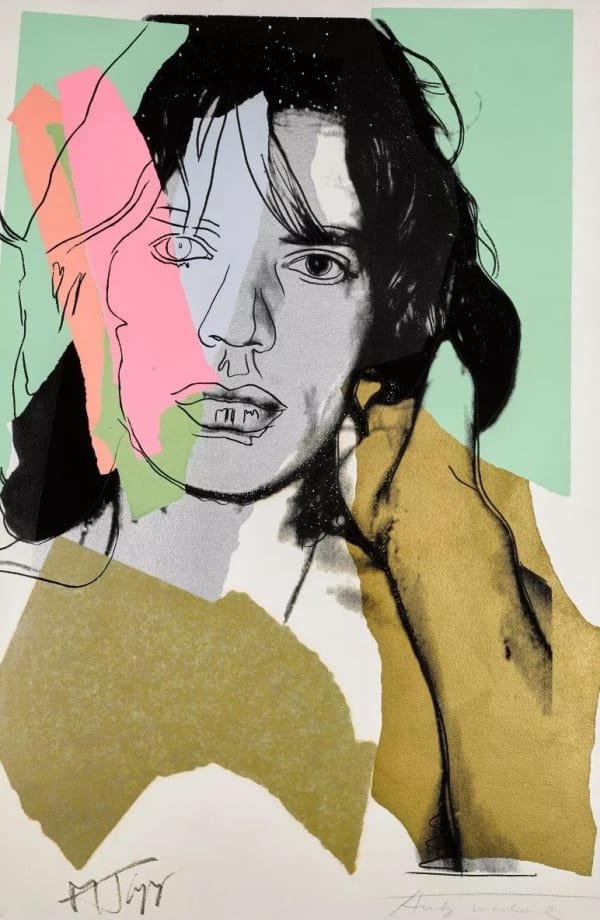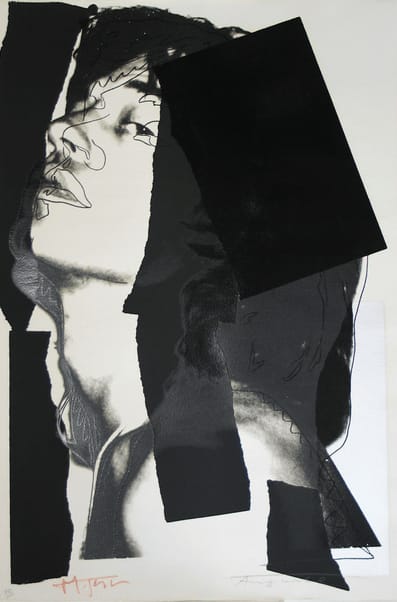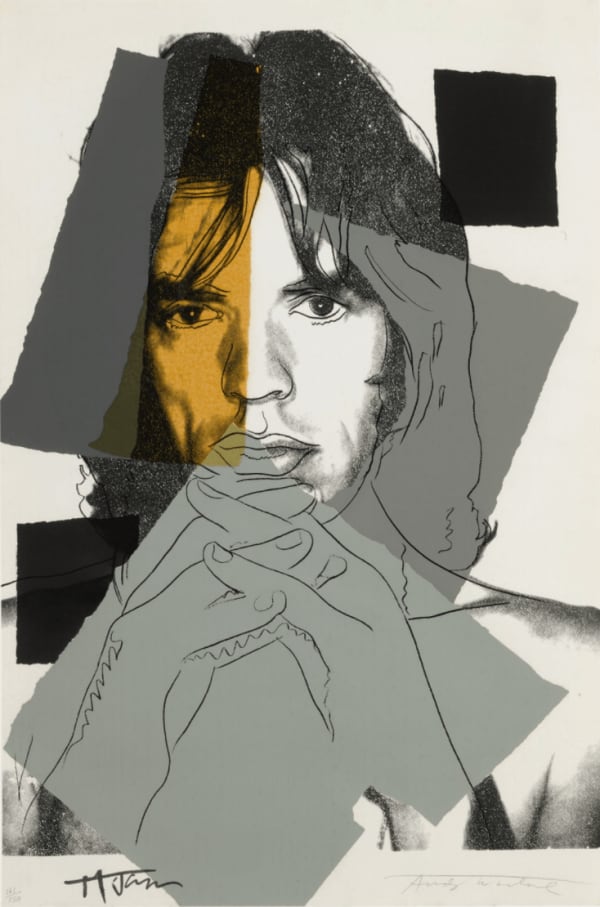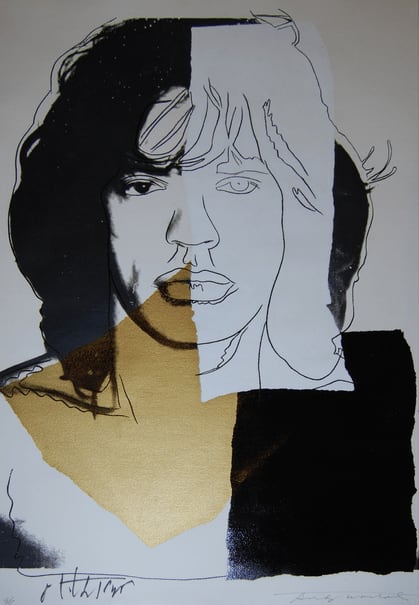-
Artworks

Andy Warhol
Mick Jagger F.S. II 145, 1975Screen print on Arches Aquarelle (Rough) paper43 1/2 x 29 in
110.5 x 73.7 cmEdition of 250 plus 50 AP, 3 PPSeries: Mick JaggerCopyright The ArtistAndy Warhol’s Mick Jagger FS. II 145 is one of ten screenprints in the artist’s celebrated Mick Jagger portfolio, created in 1975. Each portrait offers a unique perspective on the...Andy Warhol’s Mick Jagger FS. II 145 is one of ten screenprints in the artist’s celebrated Mick Jagger portfolio, created in 1975. Each portrait offers a unique perspective on the legendary Rolling Stones frontman, blending Warhol’s Pop sensibility with bold abstraction. In Mick Jagger FS. II 145, Warhol emphasizes the singer’s most iconic features—his pronounced lips, exposed torso, and elongated neck—through a dynamic composition of color blocks and gestural linework.
Warhol and Jagger first met in 1964 at a party in New York City during the Stones’ inaugural U.S. tour. At the time, both were just beginning their ascent into cultural stardom. Their relationship soon blossomed into a creative friendship, culminating in several notable collaborations. One of the most iconic came in 1971, when Jagger commissioned Warhol to design the album cover for Sticky Fingers. In a letter, Jagger granted Warhol complete creative freedom, only cautioning against anything that might delay the album’s release. True to form, Warhol ignored the latter request and delivered a provocative close-up of a man’s crotch in tight jeans—with a working zipper. The subject was actor and Warhol protégé Joe Dallesandro, and the image would go on to become one of the most memorable album covers in rock history.
Mick Jagger FS. II 145 captures this same sensual energy. Warhol’s treatment of Jagger in this series explores themes of androgyny, celebrity, and eroticism. He once described Jagger as “androgynous enough for almost anyone,” a comment that reflects both Warhol’s admiration and his fascination with the rock star’s magnetic, boundary-blurring persona. The portraits are based on Polaroids taken by Warhol himself at his home in Montauk, Long Island, where Jagger and his wife Bianca were vacationing. Bianca became a close friend of Warhol’s, and the artist even gave painting lessons to their daughter, Jade.
Unlike his earlier series—such as Marilyn Monroe or Mao—which were based on a single image repeated across variations, the Mick Jagger portfolio marks a significant departure. Each of the ten works is based on a different photograph, reflecting Warhol’s growing reliance on his own photography. This shift came in part as a response to a legal dispute following his Flowers series, in which photographer Patricia Caulfield sued Warhol for using her image without permission. Afterward, Warhol became increasingly cautious about copyright and began documenting his world with a Polaroid camera, which he often referred to as his "date" at parties.
The visual language of Mick Jagger FS. II 145 embodies the stylistic transformation of Warhol’s work during the 1970s. While undeniably rooted in Pop Art, the piece embraces a more abstract, collage-like sensibility. Flat planes of vibrant color collide with expressive pencil marks, lending the portrait a fragmented, layered aesthetic. This stylistic evolution would continue into the 1980s, influencing later portfolios like Reigning Queens and Ten Portraits of Jews of the Twentieth Century.
During this period, Warhol distanced himself from the chaos of the 1960s Factory era. The 1970s marked a more introspective and entrepreneurial chapter in his life, one focused on commissioned portraits, photography, and publishing ventures. He founded Interview magazine in 1969 with longtime collaborator Gerard Malanga and captured a diverse array of public figures—from Diana Ross and Muhammad Ali to Man Ray and Jean-Michel Basquiat.
Andy Warhol’s Mick Jagger 145 stands as a compelling intersection of art and celebrity, intimacy and spectacle. It reflects Warhol’s deep understanding of image-making and identity while capturing the charisma of one of rock music’s most enduring icons. More than a portrait, it is a vibrant expression of how Pop Art can both document and define cultural mythology.
For more information on Mick Jagger FS. II 145 or to buy Mick Jagger FS. II 145 contact our galleries using the form below.%3Cdiv%20class%3D%22artist%22%3EAndy%20Warhol%3C/div%3E%3Cdiv%20class%3D%22title_and_year%22%3E%3Cspan%20class%3D%22title_and_year_title%22%3EMick%20Jagger%20F.S.%20II%20145%3C/span%3E%2C%20%3Cspan%20class%3D%22title_and_year_year%22%3E1975%3C/span%3E%3C/div%3E%3Cdiv%20class%3D%22medium%22%3EScreen%20print%20on%20Arches%20Aquarelle%20%28Rough%29%20paper%20%3C/div%3E%3Cdiv%20class%3D%22dimensions%22%3E43%201/2%20x%2029%20in%3Cbr/%3E%0A110.5%20x%2073.7%20cm%3C/div%3E%3Cdiv%20class%3D%22edition_details%22%3EEdition%20of%20250%20plus%2050%20AP%2C%203%20PP%3C/div%3E%3Cdiv%20class%3D%22series%22%3E%3Cspan%20class%3D%22artwork_caption_prefix%22%3ESeries%3A%3C/span%3E%20Mick%20Jagger%20%3C/div%3ERelated artworks-
 Andy WarholMick Jagger F.S. II 138, 1975
Andy WarholMick Jagger F.S. II 138, 1975 -
 Andy WarholMick Jagger F.S. II 138-147, 1975
Andy WarholMick Jagger F.S. II 138-147, 1975 -
 Andy WarholMick Jagger F.S. II 139, 1975
Andy WarholMick Jagger F.S. II 139, 1975 -
 Andy WarholMick Jagger F.S. II 140, 1975
Andy WarholMick Jagger F.S. II 140, 1975 -
 Andy WarholMick Jagger F.S. II 141, 1975
Andy WarholMick Jagger F.S. II 141, 1975 -
 Andy WarholMick Jagger F.S. II 142 , 1975
Andy WarholMick Jagger F.S. II 142 , 1975 -
 Andy WarholMick Jagger F.S. II 143, 1975
Andy WarholMick Jagger F.S. II 143, 1975 -
 Andy WarholMick Jagger F.S. II 144, 1975
Andy WarholMick Jagger F.S. II 144, 1975 -
 Andy WarholMick Jagger F.S. II 147, 1975
Andy WarholMick Jagger F.S. II 147, 1975 -
 Andy WarholMick Jagger F.S. II 146, 1975
Andy WarholMick Jagger F.S. II 146, 1975
-
Join our mailing list
* denotes required fields
We will process the personal data you have supplied in accordance with our privacy policy (available on request). You can unsubscribe or change your preferences at any time by clicking the link in our emails.
This website uses cookies
This site uses cookies to help make it more useful to you. Find out more about cookies.










